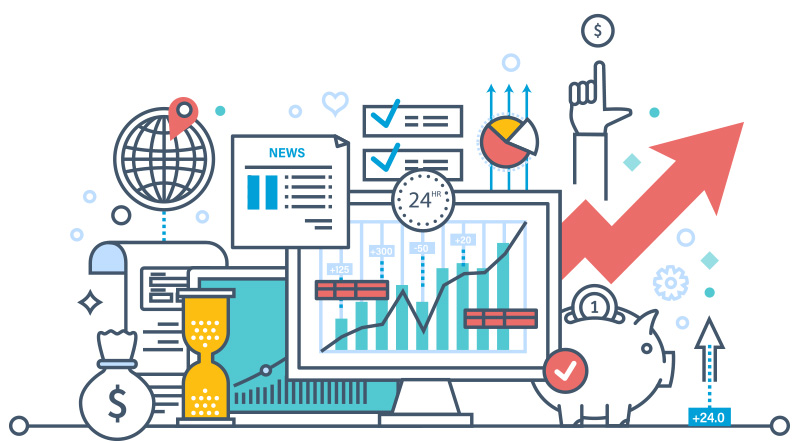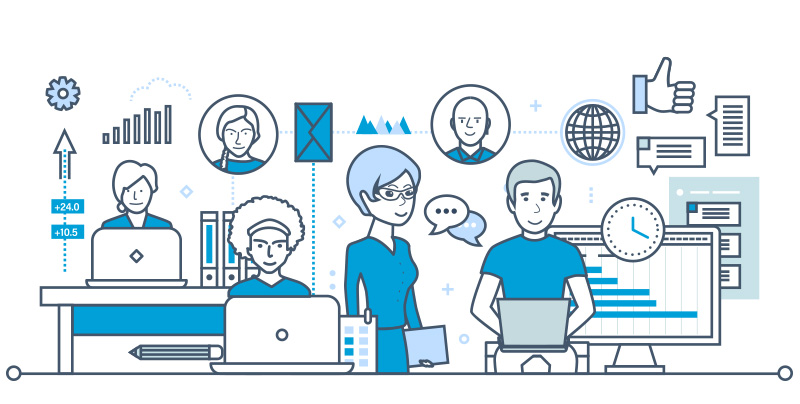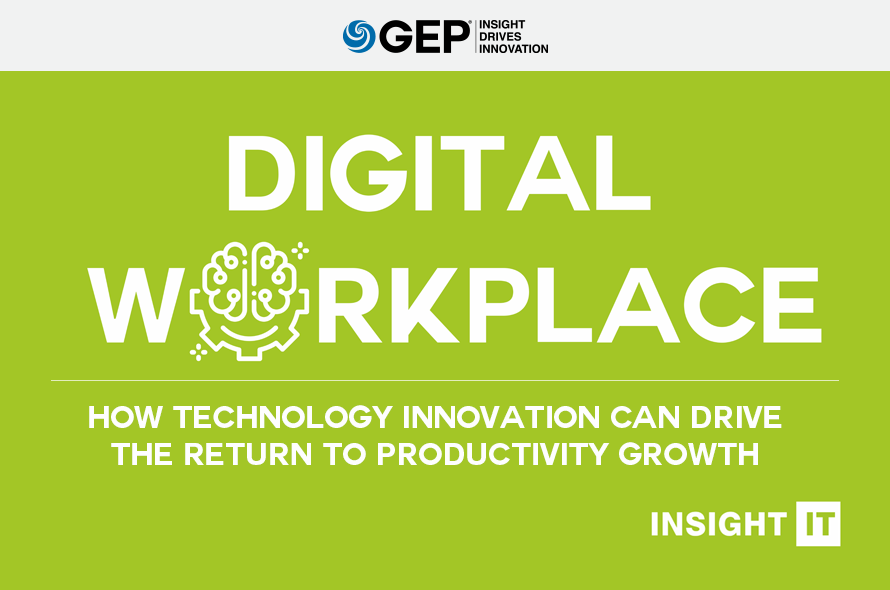The output of the modern workforce has flatlined. Productivity gains from enterprise software are drying up. Technologies that were deemed “disruptive” or “game changing” decades ago have now hit saturation. Today’s workplace must evolve and find new ways to be productive. Can technology provide a lift, again?
Cloud computing, the Internet of Things (IoT), artificial intelligence (AI), robotic process automation (RPA) and blockchain promise to do just that if exploited wisely. But integrating these new technologies with people and processes is the real challenge for businesses. Herein lies an opportunity for IT departments — by enabling synergies between key workplace elements, IT can help business functions navigate to a new paradigm in productivity, collaboration and visibility.
In this all new Insight IT piece, “Digital Workplace: How Technology Innovation Can Drive a Return to Productivity Growth,” experts from GEP explain how the CIO organization can harness technology innovation to improve productivity at the workplace by identifying three things the IT community should focus on when planning the digital workplace transformation. It also puts forth handy tips on selecting the right procurement software to boost adoption and workforce output.
A must-read for CIOs looking to address the technology needs of individual business units, and catalyze the transformation to a digital future.
Is technology still making us more productive?
Workplace productivity and output have plateaued since email, standalone applications and document sharing reached saturation. In addition, the modern workforce is more fickle than ever. Employees are more mobile in their careers, staying less time in jobs and then moving on. Thus training, retraining and knowledge-leakage are major problems, especially in light of the fact that worker productivity is largely driven by user acceptance.

When technology becomes a bottleneck, it becomes increasingly difficult to drive improvements in productivity. The modern workforce is in need of an innovation; a completely novel way of approaching productivity at the workplace. But if technology created this problem, can it also be the catalyst that provides a solution?
 Walking Down Technology Lane
Walking Down Technology Lane
Remember when “mail” consisted of handwritten letters in envelopes delivered by the post office, “meetings” meant speaking to somebody in person, and “records” were reams of paper organized in colored folders? Back in the day, office tasks were largely manual, time-consuming and cumbersome, with a high likelihood of human error.
Then came the computer. And after that, the early internet and the unprecedented speed, convenience and efficiency of email — a major upgrade from traditional mail, and one that rendered a number of human-performed activities obsolete. It was practical, easily adoptable and very economical. A disruptive invention in its time, email completely transformed the workplace, poising it perfectly for the digital revolution that was to follow.
The “Email Experiment”
The introduction of email undoubtedly drove huge productivity gains — but after more than two decades, we're at a critical mass. The flatlining of workforce output is probably because we're reaching a limit to how productive we can be working the way we currently do, which is almost the same as how we worked a decade ago. It still takes about the same time to compose an email as it did in 1998. Meanwhile, the volume of email has vastly increased — but the rate at which we can handle all that email has not kept pace.
 Embracing the Digital Workplace
Embracing the Digital Workplace
The workplace has evolved to embrace new technologies like cloud computing, the Internet of Things (IoT), artificial intelligence (AI), robotic process automation (RPA) and forthcoming innovations such as blockchain, all of which promise to deliver great rewards if exploited wisely. But integrating these new technologies with people and processes — thus meeting the definition of the “digital workplace” — is the real challenge for businesses.
The digital workplace offers not just the opportunity to rethink traditional business practices, but to enable synergy between key workplace elements. More than creating a virtual equivalent of the physical workplace, the digital workplace nurtures an environment that permits more to be done — new tasks, accomplished through greater collaboration and improved visibility.
Through digitization, people and business processes can be aligned with technology to deliver a step-change in operational efficiency and exceed today's business goals, defining new goals for tomorrow.
 Every CIO's Agenda — Building a Digital Workplace
Every CIO's Agenda — Building a Digital Workplace
The CIO's remit has been shrinking. Increasingly, infrastructure and application workloads are disappearing and legacy systems are becoming outmoded. Businesses require their IT departments to help them navigate to a new paradigm in productivity.

IT, in response, must break free of the “old mold” — acting as a gatekeeper (and sometimes effectively a barrier) to innovation — and must give way to becoming an enabler and change leader. And implementing a digital workplace is perhaps the best way to break through the technology bottleneck. It will allow IT to truly transform from gatekeeper to navigator.
Here are three things the IT community should focus on when planning the digital workplace transformation:
DATA
Aggregating all the user data in a digital community will be central to the architecture. Therefore, understanding the data landscape must be the first and foremost priority. Data can be analyzed for insights and trends that help the organization make business decisions. Data categorization and analysis are central to operational efficiency and by extension to business agility. The key questions for IT are: How can we help our stakeholders acquire more and better-quality intel? And then, how can we help them to share, analyze, and understand that data in ways that positively impact the company's growth and revenues? But it all starts with a complete understanding of where the data is, who holds the keys to each source and how those sources interoperate to provide the complete overview.
USER EXPERIENCE
User distraction and developer complacency are very real dangers. Worker productivity can be easily stifled by outdated, difficult-to-use software, thus reinforcing the need for software which fits within the digital workplace paradigm. Simply introducing new software may not necessarily mean implementing a digital workplace. And the old-school selection methodology of feature counting or sticking with existent ERP vendors does nothing to create one.
The digital workplace is about doing something different, and automatically upgrading to a new version of old software is not it. The productivity limits we have hit are very much connected to how we use that software. If people are going to change their way of working, the new methods need to be easy, intuitive and appealing. The digital workplace must therefore be collaborative, seamless, unified and universally accessible, which means that the software needs to offer a simpler and friendlier user experience than it does today.
TASKFLOW UNIFICATION
Seeking out individual applications for individual tasks is no longer feasible — that's just doing the same thing in a different room, as it were. What business users need now is inherent flexibility with intelligent, intuitive workflows across business units, regions and external stakeholders. So, IT needs to guide them to software that can enable fluid information, process and workflow, to speed up and streamline processes with end-to-end visibility. Incidentally, off the table entirely should be software selected purely on function and feature count alone. Productivity gains just aren't to be had any more from simply increasing complexity. Complexity must be bolstered by interoperability and usability in equal parts.
Procurement — A Great Starting Point
Procurement is increasingly acknowledged as a crucial business function, and there is an opportunity for IT to help procurement advance toward maturity by developing its version of the digital workplace.
We need to change the way we work, which means changing the software we use, to truly transform. Leading procurement software like GEP SMART can catalyze a whole new level of capability, offering not a mere improvement but a quantum jump beyond on-premise ERP systems:
- Adoption: Intelligent, intuitive interfaces and user-centric design boost adoption and compliance
- Mobility: Manage source-to-pay processes anytime, anywhere, and on any device
- Security: Multilayer security protocols ensure the highest levels of data protection
- Flexibility: Seamless integration with all major back-end systems
- Cost: Cloud economics virtually eliminate infrastructure, maintenance and operational expenses
- Collaboration: Greater synergy between procurement, finance and external teams
 Change Is Coming — Where Do You Stand?
Change Is Coming — Where Do You Stand?
IT is the logical function to take the lead on implementing a digital workplace in its bid to become a more proactive department. Businesses today have a choice — they can either give the project to IT or approach a cloud provider. While the software in question might be the same in both cases, IT needs to add value to stay in the loop and remain profitable as a function. So what can IT bring to the table? Leadership, guidance and a can-do attitude.
In essence, a digital workplace is the key to the next generation of business success. Change is coming, and companies can either lead from the front or follow at greater cost. CIOs have the chance to pioneer the move into this new world, spearheading the evolution of the digital workplace and recharging IT's mission in a new era of relevance and value.

